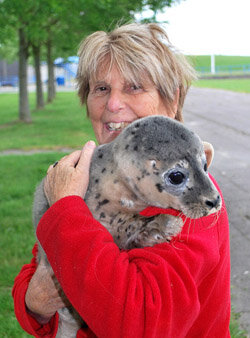Dutch vet dedicates years to save Caspian seals in Iran

TEHRAN – Lenie 't Hart, a 78-year-old Dutch animal caretaker and animal rights activist, has spent 50 years on preserving seals, especially Caspian seals, which are exposed to environmental pollution and are at risk of extinction.
In 2008, Iran’s Department of Environment started the seal conservation program with the support of the Zeehondencreche, a seal protection center founded by Lenie 't Hart.
She comes to Iran annually to help the endangered species of seals.
Caspian seal, the sole marine mammal inhabiting the Caspian Sea, is endangered according to the International Union for Conservation of Nature and Natural Resources (IUCN), as recently demonstrated to have declined by more than 90 percent since the start of the 20th century.
According to the latest census conducted in 2016, the population of Caspian seals has reached less than 70,000; while their population once stood at about one million in the country.
The oil spill, industrial waste as well as heavy metals, agricultural pesticides, radioactive waste, wastewater and household waste entering the sea, and noise pollution caused by oil and gas refineries, and excessive boat traffic have pushed the species toward extinction through poisoning them.
Releasing and treatment of injured seals caught in fishing nets, recording data of seals, sampling live animals, and collecting tissue samples from carcasses to control the Caspian ecosystem and its biological health, are among the measures Hart has taken in Iran.
She emphasizes that cooperation among Caspian Sea littoral states is essential to rescue the seals, adding "If the neighboring Caspian countries fail to find a suitable mechanism for rescuing the species, the remaining population will be completely disappeared over the next ten years."
She has set up a medical and research center with the help of Iranian colleagues in Ashuradeh, the only island of the Iranian coast of the Caspian Sea, to assist locals in rescuing the seals.
The Caspian seal medical and research center teaches fishermen the importance of seal protection by holding workshops. Now, fishermen cautiously rescue the seals trapped in fishing nets and no longer see them as a dangerous piscivore. Moreover, the center rewards anyone who rescues a seal.
In addition to training the fishermen, she has asked Iranian Turkmen women whose husbands were fishermen to make carpets and rugs displaying seals’ picture. She sells the rugs in the Netherlands and the revenue is provided to the fishermen's families.
Caspian seals population shrinking alarmingly
Amir Shirazi, a representative of the Caspian seal medical and research center in Iran, told IRNA on Monday that despite the sharp decline in this endangered population, hunting and exploitation of seals in Russia continues to be a serious problem which needs to be tackled.
The population of the valuable species in the Iranian part of the Caspian Sea has also fallen sharply, which is mainly caused by being caught in the fisherman's net, he lamented.
During the past hunting seasons (beginning on October 7), a number of Caspian seals were caught daily in the fisherman's net, but this year only 4 cases have been reported, he stated.
He went on to say that another reason behind the decline of seals population in the country is the decline of fishes favored by seals such as Black Sea sprat, adding, seals are likely to migrate due to insufficient food.
The Caspian Seal life can be divided into three periods, he said, adding, they spend the first period on breeding, the second period on hair shedding cycle and the final period of their life spends on migration to southern and central parts of the Caspian Sea including Iran, Turkmenistan, and Azerbaijan.
Caspian seals are usually born in Russian ice lands and due to the possibility of camouflage in ice and snow, or less likely to be hunted, but habitat destruction in Iran has resulted in a rare sad event, as two pups were born in Gilan province last year, but their carcass was found off the coast after a short time, he regretted.
Due to the occupation of the Caspian coastline in Iran by government agencies and individuals constructing villas and settlements, the Caspian seals can only rest on small parts of the shores of Miankaleh Wildlife Refuge and Ashuradeh Island if there are no fishermen, he lamented.
Increasing public knowledge and awareness of local communities is an effective step in achieving goals of protecting the seals in addition to the involvement of prominent groups such as artists, athletes, and other social, cultural and political influencers, he concluded.
------------------ Caspian seals included on CMS
Caspian seals are included in Appendices I and II of the Conservation of Migratory Species of Wild Animals (CMS).
As per Appendix I of the Convention, poaching and illegal fishing activities is banned to save the animals from extinction, while Iran has not had a share in illegal fishing of the species since the very beginning, she concluded.
Over the 12th Meeting of the Conference of the Parties (CMS COP12) to the Convention on the Conservation of Migratory Species of Wild Animals (CMS), administered by UN Environment on October 28, 2017, Caspian seals were included on Appendices I and II of the Convention.
According to the Conservation of Migratory Species of Wild Animals Website, Appendix I comprises migratory species that have been assessed as being in danger of extinction throughout all or a significant portion of their range.
Appendix II covers migratory species that have unfavorable conservation status and that require international agreements for their conservation and management, as well as those that have a conservation status that would significantly benefit from the international cooperation that could be achieved by an international agreement.
FB/MG
Leave a Comment